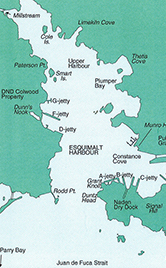For thousands of years prior to the arrival of Europeans, Esquimalt Harbour was the home of Lekwungen-speaking peoples, ancestors of the present day Esquimalt Nation. There was a winter village site where the Esquimalt Nation village is today. The surrounding harbour was an important source of food including clams, ducks, geese and fish. Schools of herring came into the harbour to spawn, and the eggs were harvested.
 Esquimalt Harbour was the site of the first landing by Europeans in the Victoria area. Don Manuel Quimper from Spain made exploratory visits in the 1790s and named the harbour Puerto de Cordova. By the 1840s, the British Royal Navy began using the natural protected harbour as a west coast naval base.
Esquimalt Harbour was the site of the first landing by Europeans in the Victoria area. Don Manuel Quimper from Spain made exploratory visits in the 1790s and named the harbour Puerto de Cordova. By the 1840s, the British Royal Navy began using the natural protected harbour as a west coast naval base.
Since the 1800’s Esquimalt Harbour has been home to many different industrial activities including shipbuilding and repair, coal storage, shipping, sawmills and gristmill. Chemical wastes from these industries were historically washed directly into the harbour. New technologies are now used to minimize and eliminate pollution to the harbour, but sediment contamination remains a concern. Extensive log booms used to supply local sawmills throughout most of the 1900’s have also had serious ecological impact on the harbour. Today, wood and logging debris such as cable and chain blanket about 16% of the harbour seabed. Masses of wood waste radically alter the chemical and physical nature of the seabed, smothering bottom-dwelling organisms and creating sulfide-rich anoxic conditions during the decomposition of the debris.
The Department of National Defence (DND) has initiated an extensive contaminated sites remediation and monitoring program, and many of the historically contaminated sites have now been remediated.
In 2013, DND created three nearshore reefs in Esquimalt Harbour to offset any future sub-marine works that may occur near their jetties. Each reef is composed of large boulders and about 20 m x 40 m in size. It is estimated that the reefs will create about 11,000 m2 of rocky reef habitat, providing substrate and cover for invertebrates, seaweeds and fish.
© Image courtesy of Bright and Reimer, 1993